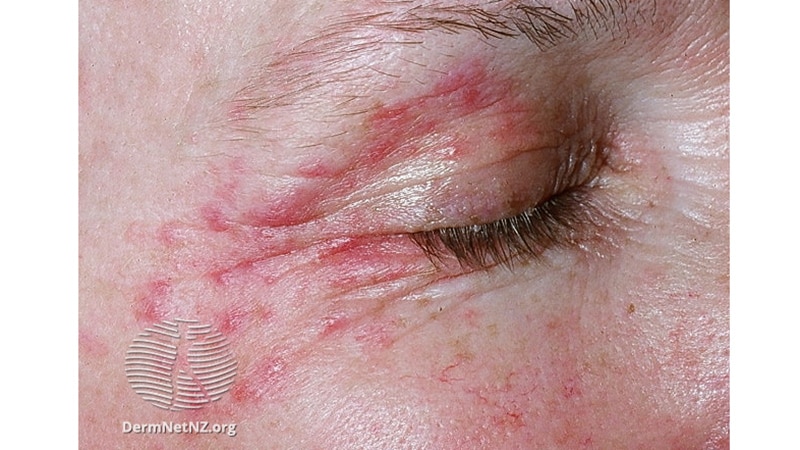
Various ingredients in topical eye medications may be causing allergic contact dermatitis at higher rates than assumed, a small retrospective cohort study suggests.
“Allergic contact dermatitis caused by topical ophthalmic medications (OftACD) is frequently difficult to confirm with patch testing and, therefore, it is considered uncommon,” senior study author Margarida Gonçalo, MD, PhD, a professor of dermatology at the University of Coimbra Faculty of Medicine and University Hospital in Coimbra, Portugal, and her colleagues, wrote in their article, published online in Contact Dermatitis.
“This study reinforces previous findings in OftACD, such as an older age of onset, and the importance of antibiotics, contrasting with the progressively lower prevalence of preservatives as culprits. In addition, it raises awareness for the sensitization to beta-blockers and other anti-glaucoma drugs, which is probably underestimated,” they add.
The researchers collected retrospective data from a cohort of 65 patients with suspected OftACD who had been patch-tested using a series of topical drugs and excipients, including betaxolol and timolol, in one academic dermatology clinic between 2005 and 2021. In most patients, frequently used ophthalmic medications, and the patients’ own products, were also patch tested “as is.”
The 44 patients with positive patch tests averaged around 63 years of age and 38 of them were female. Of the 102 positive reactions in the cohort, 56 were linked with active ingredients, especially aminoglycoside antibiotics; 24 were linked with excipients such as sodium metabisulfite; and 22 were linked with topical products tested “as is,” most of which contained beta-blockers.
“Testing with patients’ own products may be useful when no commercialized allergens are available or to circumvent the low sensitivity of the patch testing for some suspected ingredients, but multicenter studies to find standardized patch test material for testing anti-glaucoma eye-drops is a real unmet need,” the authors recommend.

Natalie A. Afshari, MD
“This interesting and important study helps us understand the extent of contact dermatitis with topical ocular treatments,” Natalie A. Afshari, MD, FACS, chief of cornea and refractive surgery at the Shiley Eye Institute of the University of California, San Diego, told Medscape Medical News.
“It was important to do this study so we can understand the rate of positive skin allergy testing in patients with contact dermatitis from topical eye drop treatments,” she added in an email.
But Afshari pointed out that the study’s retrospective design is a limitation. “Also, the reason the percentage of the allergic skin testing was so high is that patients in the cohort were suspected to already have ocular allergy.”

Kimberly McPeeks, MPAS, PA-C
For Kimberly McPeeks, MPAS, PA-C, a physician assistant specializing in dermatology at Atrium Health Wake Forest Baptist in Winston-Salem, North Carolina, “this study highlights the frequency of allergy to ophthalmic active ingredients, as well as the lack of commercially available patch test preparations of these ingredients.”
“Hopefully, this study will assist patch test providers in keeping sources of ophthalmic contact allergy front of mind when evaluating and testing patients with eyelid dermatitis, not just patients with conjunctival symptoms, especially in older populations,” she said in an email.
Knowing whether the patch tests in the study were performed by the same person would be helpful, McPeeks noted, because individual providers may have differed in their interpretations of results.

Alex A. Huang, MD, PhD
Alex A. Huang, MD, PhD, associate professor of ophthalmology, glaucoma specialist, and cataract surgeon at the Shiley Eye Institute, said in an email that the study “nicely describes a challenge not uncommonly seen in ophthalmic practices.”
“Contact dermatitis due to topical medications is a growing problem due to the increasing number of new topical drugs and the polypharmacy that can arise from treating complex and chronic conditions such as glaucoma,” he explained.
“Aminoglycosides causing contact dermatitis is a classic observation and a pearl in glaucoma management for rare cases of fluid leaks after glaucoma surgeries,” he said. “Aminoglycosides provide antibiotic coverage coupled with an ocular surface reaction involving hyperemia and inflammation that can serve to help close leaks.”
Huang added that although ophthalmic medication preservatives may cause contact dermatitis, preservative-free formulations are available for many drugs and help solve this problem.
The authors, Afshari, McPeeks, and Huang declare no relevant financial relationships. Topical drugs and excipients were “supplied by the pharmaceutical industry.”
Contact Dermatitis. Published online June 17, 2022. Abstract
For more news, follow Medscape on Facebook, Twitter, Instagram, and YouTube
Source: Read Full Article